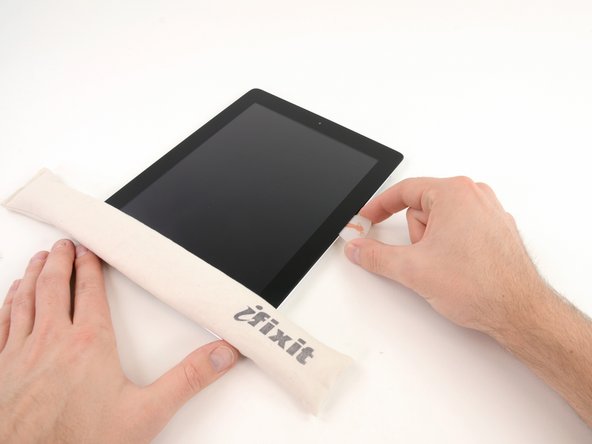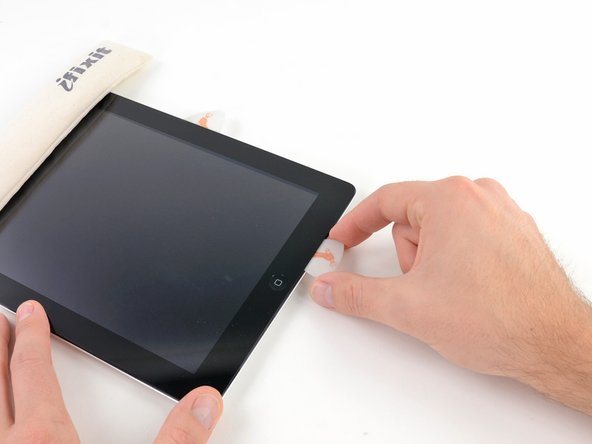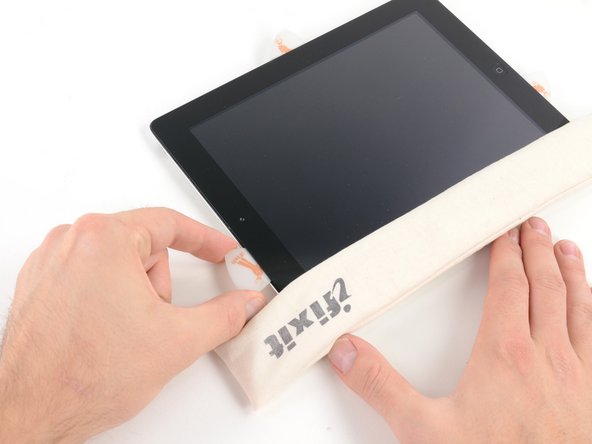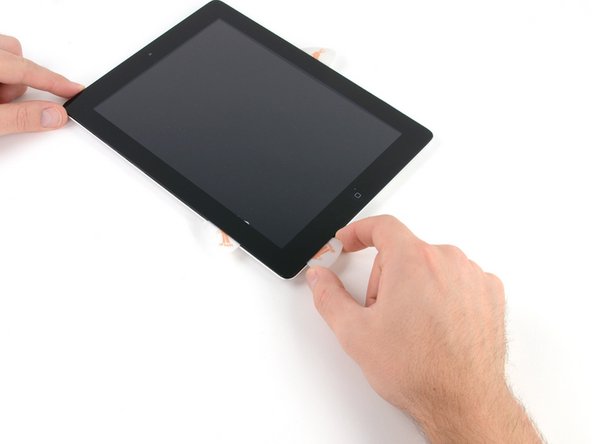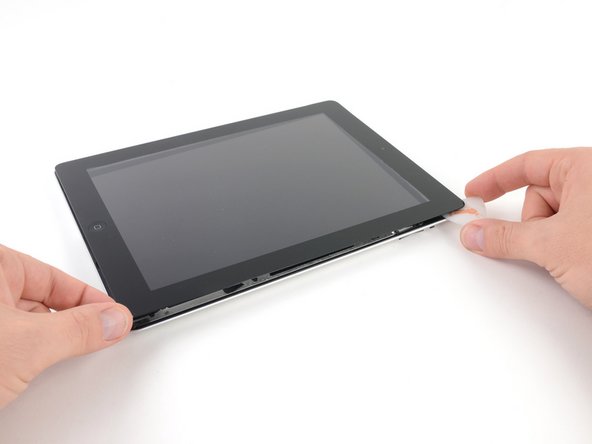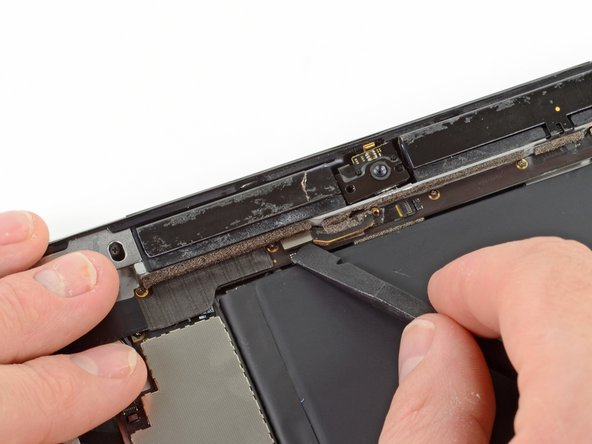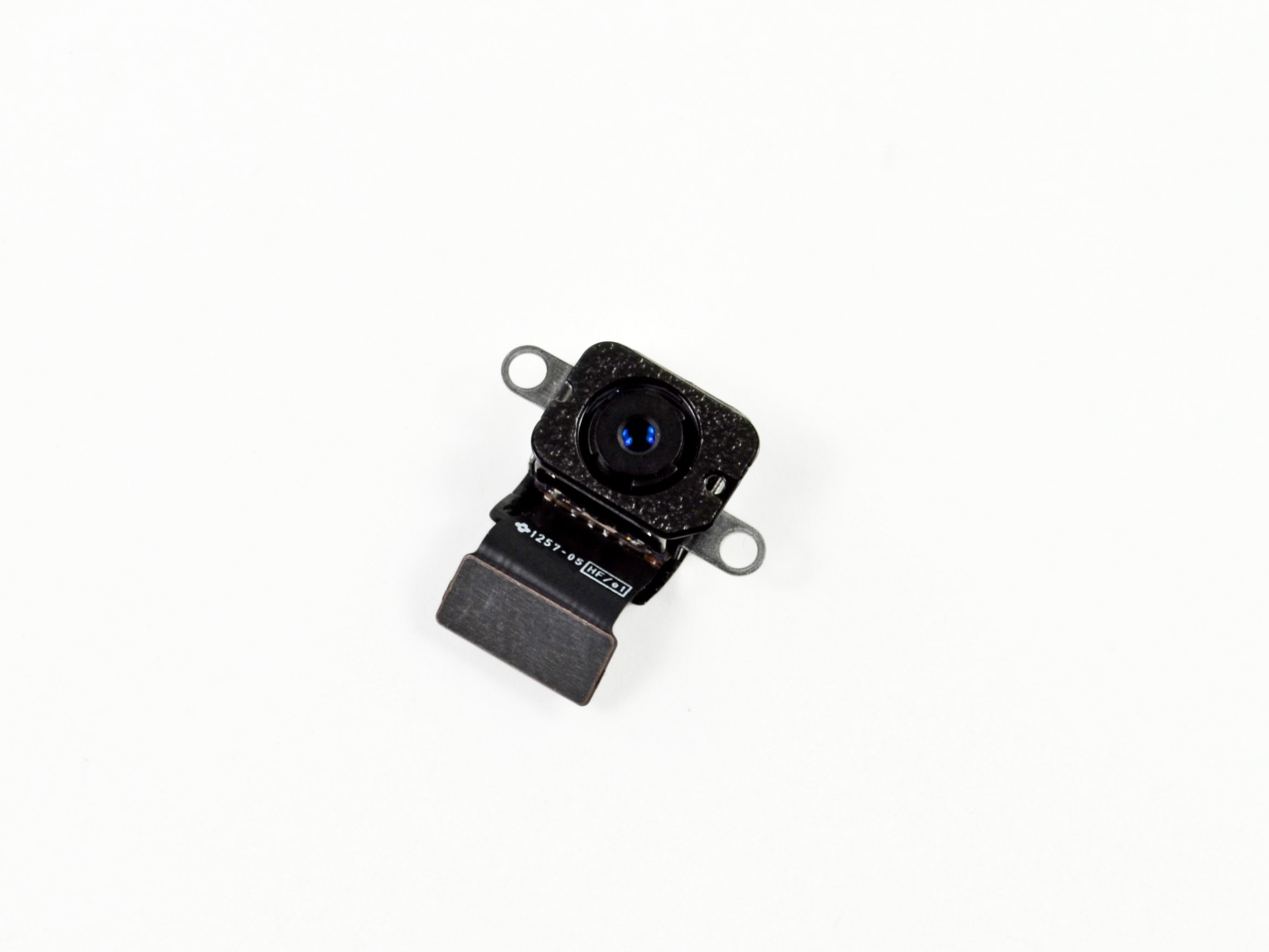iPad 4 GSM Rotation Lock/Mute Switch Replacement
Duration: 45 minutes
Steps: 67 Steps
Time to swap out that rotation lock/mute switch! It's a quick fix that’ll have your device feeling brand new in no time. Just follow the steps carefully, and you’ll be back to your favorite apps with ease. Need an extra hand? No worries—if you're feeling stuck, you can always schedule a repair for professional help.
Step 1
For carousel microwaves: double-check that the plate spins without a hitch. If your iOpener gets stuck, it might overheat and cause a burn, so keep it moving!
It's a good idea to give your microwave a quick clean before diving in. Any leftover mess on the bottom might end up on your iOpener, and we definitely don't want that.
- Pop the iOpener right in the middle of your microwave. It's showtime!
Tools Used
Step 2
Keep an eye on your iOpener’s temperature—overheating it might cause it to pop like a balloon! Never heat it beyond 100˚C (212˚F).
If your iOpener looks puffed up or swollen, don’t touch it—better safe than sorry.
If it’s still too toasty in the middle to handle, just keep using it and let it chill out a bit before reheating. When warmed just right, your iOpener should stay cozy for about 10 minutes.
Depending on your microwave's wattage, the heating time may vary. The iOpener is good to go when it's almost too hot to handle with your bare hands. Keep an eye on it, and remember: a little heat goes a long way!
- Pop the iOpener in the microwave for about thirty seconds to get it nice and warm.
- Keep the iOpener toasty by reheating it for another thirty seconds whenever it starts to cool down during the repair.
Tools Used
Step 3
The iOpener gets really hot, so handle it with care! You might want to grab an oven mitt to avoid any burns.
- Take the iOpener out of the microwave, grabbing it by one of the flat ends to keep your fingers safe from that warm center.
Tools Used
Step 4
Heads up, the iOpener can get pretty hot! Make sure to hold it by the end tabs to avoid any burns.
No microwave? No problem! Just heat up your iOpener in some boiling water instead.
- Grab a pot or pan and fill it up with enough water to give your iOpener a nice bath. We want it fully submerged!
- Bring that water to a roaring boil, then turn off the heat. We're not trying to cook anything here!
- Time to pamper your iOpener! Pop it into the hot water for about 2-3 minutes—just make sure it's all the way in there, soaking up the warmth.
- Carefully use some tongs to fish out the heated iOpener from its cozy water spa.
- Give that iOpener a good towel dry—nobody likes a soggy iOpener!
- And voila! Your iOpener is all set for action! If it needs a little more warmth later on, just repeat the process: boil the water, turn off the heat, and let it soak again for 2-3 minutes.
Tools Used
Step 5
- Grab a SIM eject tool or a paperclip (yes, the one you've probably got in your drawer somewhere), and gently eject the SIM tray. Easy, right?
Step 6
- Gently pull the SIM tray out of its slot and take it out of your iPad.
- If you're swapping the SIM card, pop the old one out of the tray and slide the new one in.
Step 7
Pop on some safety glasses to keep your eyes safe, and handle that LCD screen like it's your favorite vinyl—gentle and with care!
This will keep any sneaky glass shards in place and give the display some solid backup while you pry it open.
- Got a cracked display? No worries! Let's keep that glass from shattering even more and protect those precious fingers of yours by slapping some tape on it.
- Grab some clear packing tape and layer those strips over your iPad's screen until it's completely covered. You're doing great!
- Now, just follow the rest of the guide as best as you can. Remember, once that glass starts to break, it might want to keep cracking while you work. If that happens, you might need to use a metal prying tool to gently scoop out the pieces.
Step 8
Just a friendly reminder: while tackling this task, you might encounter some broken glass. To keep your eyes safe from any unexpected flying bits, we highly suggest sporting a pair of safety glasses. Better safe than sorry, right?
- Place the iOpener flat along the right edge of the iPad, pressing it down so it makes solid contact with the surface.
- Let it chill there for about 90 seconds to warm things up before you try to pop open the front panel.
Tools Used
Step 9
It might take a little elbow grease to slide that opening tool's tip between the glass and plastic. Just take your time and stay steady, gently wiggling that plastic tool back and forth as needed.
- Check out the tiny gap in the iPad's adhesive ring at the top right corner, about 2.0 inches (~5 cm) down from the top edge. This little weak spot is your entry point.
- Line up your tool with the mute button. Gently slide the tip of a plastic opening tool into the crack between the front glass and the plastic bezel. Just nudge it in just enough to pop the gap open a bit.
Step 10
- Carefully slide your tool right between the plastic display bezel and the front glass—just the right spot to work your magic without any oops moments.
Step 11
- With the plastic opening tool snugly nestled between the front glass and plastic bezel, gently slide a plastic opening pick into that little gap, right alongside your trusty tool. Keep it smooth and steady!
Step 12
- Gently slide the plastic opening tool out from the iPad, then take the opening pick and carefully slide it under the front glass, going about 0.5 inches deep. Keep it steady and make sure not to rush—it’s like giving your iPad a little spa treatment.
Step 13
- As you carefully loosen the adhesive on the right side of the iPad, go ahead and give the iOpener another warm-up, then pop it back onto the bottom edge to keep things cozy.
Tools Used
Step 14
This adhesive is seriously stubborn, so be ready to bring your A-game. Take it slow and steady!
If you spot the tip of the opening pick sneaking out from under the front glass, gently pull it back just a tad. Using the pick this deep won’t cause any damage, but it might spread some sticky adhesive onto the LCD, so keep an eye out!
- As you warm up the bottom edge with the iOpener, start peeling away the adhesive from the right side of the iPad.
- Gently slide the opening pick down the edge of the iPad, working to free the adhesive as you go.
Tools Used
Step 15
You might need to slide the heated iOpener back onto the right edge of the iPad while loosening the adhesive. How much you need to move it depends on how long the iPad has cooled down during your work. Keep it warm enough to make the job easier!
- If your opening pick gets caught in the adhesive, just give it a little roll along the iPad’s edge to keep loosening that sticky stuff.
Tools Used
Step 16
- Before you start, grab that first pick and carefully slide it into the bottom corner of the iPad. To keep things neat, pop in a second pick along the right edge of the front glass so the adhesive doesn't get all clingy again.
- Now, let's give that iOpener another heat session! Once it's nice and warm, move it to the top edge of the iPad. You’re almost there!
Tools Used
Step 17
The Wi-Fi antenna is secured to the bottom right edge of the iPad’s rear case with screws and a cable. Because of how this little guy sits, it’s super important to handle it with care—one wrong move and the Wi-Fi antenna could be toast.
- Alright, folks! Time to tread carefully through the next steps.
- We'll need to gently free the adhesive holding the antenna to the front panel—no pressure! Just keep in mind the delicate connections at the bottom of the iPad. So, let's take it step by step and make this as smooth as possible!
Step 18
Don't slide the pick too far past the bottom right corner! You might accidentally mess with the Wi-Fi antenna. Stay on track to keep everything running smoothly!
- Gently glide the opening pick around the bottom right corner of the iPad, freeing up the adhesive that’s holding it down.
Step 19
- Gently glide the tip of your opening pick along the bottom edge of the iPad to free up the adhesive holding down the Wi-Fi antenna.
Gently slide the opening pick along the bottom right edge of the front panel. Be extra careful near the corner—there's a Wi-Fi antenna hiding close by, and it's easily damaged if the adhesive is lifted incorrectly. Take your time!
Don’t yank the pick all the way out from under the front glass—just give it a gentle tug so about 1/8" (3 mm) of the tip stays tucked underneath. Keep it cozy under there!
Step 20
- Once you've navigated past the Wi-Fi antenna (that's about 3 inches, or 75 mm, from the right edge, right next to the home button), slide that opening pick in all the way. You're doing great!
- Now, gently glide the pick to the right and let it work its magic, breaking free the adhesive that's holding the Wi-Fi antenna to the front glass. You're almost there!
- Just a heads up: the antenna is secured to the bottom of the iPad with screws and a cable. This step is crucial as it separates the antenna from the front panel, keeping it safe from any mishaps when you lift off the panel. Keep it up!
Step 21
Keep the iOpener to a one-minute limit per session, and be sure to give it a breather for at least two minutes before giving it another go!
If the adhesive has gotten a bit too cool along the bottom edge, give that iOpener a quick reheating session to warm things up where you're working. A little extra heat can work wonders!
- Keep sliding the opening pick under the bottom edge of the iPad, carefully pulling it out enough to curve it around the home button. Once you’ve passed the home button, pop the pick back in to about 1/2 inch (10 mm) deep and keep going!
Tools Used
Step 22
For iPad 4 models, gently insert the pick about 1/2 inch (10 mm) deep in this area, but be careful not to go too far – we don’t want to mess with that home button ribbon cable!
- Keep working that adhesive loose all along the bottom edge of the iPad until it's free.
- Once you're in, leave the opening pick snugly tucked under the front glass close to the home button.
Step 23
- Pop that iOpener into the microwave for a quick reheat and then place it on the left edge of your iPad. This will help warm up the adhesive in that area and make things easier for you.
Tools Used
Step 24
If the adhesive has cooled down too much, no worries! Just pop the iOpener back along the top edge and keep going. If it's feeling a bit too cool, give it another heat-up and you're good to continue.
- Gently slide the opening pick along the top edge of the iPad, easing it out just enough to navigate around the front-facing camera bracket.
- Heads up: the adhesive here is super stubborn, so you might need to flex a bit of muscle. Take it slow and steady to avoid any slips or scrapes on you or your iPad.
- If the pick starts to get stuck in the adhesive, try "rolling" it as demonstrated in step 9 to ease it through.
Tools Used
Step 25
If the adhesive is feeling nice and warm, go ahead and peel off the iOpener from your iPad for smoother work. But if the sticky stuff is still holding on tight, just heat up the iOpener again and place it on the left edge to keep things easy as you continue working.
- Gently peel back the adhesive along the top edge of your iPad, and carefully slide the opening pick around the top left corner. Keep things smooth and steady—you're doing great!
Tools Used
Step 26
The digitizer cable hangs out about 2" (50 mm) up from the bottom of your iPad. When sliding your pick, ease up and stop once you hit around 2.25" (60 mm) from the bottom to keep things safe and sound.
- Gently slide your opening pick along the left edge of the iPad, carefully loosening the adhesive as you go. Heads up: the adhesive is pretty thin here because of the digitizer running along the entire left side. Keep your pick shallow—no deeper than about 10 mm (half an inch)—to avoid any accidental damage to the digitizer.
Step 27
Heads up! The bottom of the digitizer cable is just about an inch (25 mm) from the iPad’s bottom edge. Take it slow and steady to avoid cutting through this little guy.
- Grab that trusty opening pick you've got chilling at the bottom edge of your iPad. Time to give the adhesive at the bottom left corner a gentle nudge and set it free!
Step 28
Some of the glue around the edges of the iPad might have decided to stick back like it’s got commitment issues. If that’s the case, gently slide a pick under the edge where the glass is still hanging on and carefully slice through the adhesive to free it up.
- Grab an opening pick and gently slide it under the bottom right corner of your iPad. Once it’s in, pry it up carefully and use your fingers to pull it free.
Step 29
Watch out for any sticky adhesive leftovers, and grab an opening pick to carefully slice through any glue still holding the front panel in place.
- Grab your iPad by the top and bottom right corners and gently twist the front glass away from the device like you're unveiling a surprise!
- As you put everything back together, don’t forget to give the LCD a little love with a microfiber cloth and some compressed air to banish any dust bunnies or fingerprints before sealing the glass back on.
Step 30
The bottom left screw is hiding behind the home button ribbon cable connector. Gently nudge that ribbon cable aside so you can get to that sneaky screw and remove it with ease.
- Unscrew the four 2 mm Phillips #00 screws holding the LCD in place on the aluminum frame. Take them out carefully and set them aside for later—your future self will thank you.
Step 31
Handle the LCD with care! That ribbon cable is delicate and could snap if you bend it too much. Keep it gentle, and you'll be golden!
- Grab your trusty plastic opening tool or spudger and gently lift the right edge of the LCD out of the iPad. You've got this!
- Now, let's give that LCD a little twist! Rotate it along its left edge and carefully lay it down on top of the front glass panel. Easy peasy!
Tools Used
Step 32
- Grab your trusty spudger and gently lift the tape off the LCD ribbon cable connector. You’ve got this!
Tools Used
Step 33
- Gently lift the little flap holding the LCD ribbon cable in place on the ZIF connector.
- Carefully wiggle the LCD ribbon cable out of its slot on the logic board using your fingers or tweezers.
- If your iPad’s screen doesn’t light up after reconnecting the LCD cable, try a force restart by holding the power and home buttons simultaneously for about ten seconds until the Apple logo shows up.
Tools Used
Step 34
- Careful now—gently lift the LCD away from the front panel without touching its front side.
Step 35
If you spot any electrical tape hiding the Wi-Fi antenna, speaker cable, or home button ribbon cable, go ahead and peel it off gently.
Step 36
- Gently lift the little flap on the home button ribbon cable ZIF connector to unlock it.
Step 37
- Grab a trusty pair of tweezers and gently pull the home button ribbon cable straight out of its cozy socket on the logic board. You've got this!
Tools Used
Step 38
- Carefully guide the home button ribbon cable out from its snug little spot in the rear case. You've got this!
Step 39
- Gently use the tip of your spudger to lift the tape holding the digitizer ribbon cable onto the logic board—think of it like peeling a sticker without tearing it. Take it slow, you got this!
Tools Used
Step 40
- Lift the retaining flap on both of the digitizer ribbon cable ZIF connectors with care.
Step 41
- Gently slide the flat end of your spudger under the digitizer ribbon cable to break up the stubborn adhesive holding it down.
- Carefully pull the digitizer ribbon cable straight out from its connectors on the logic board—no wiggle dance needed!
Tools Used
Step 42
- Gently peel back the digitizer ribbon cable, then grab the flat end of your spudger and carefully work it under the adhesive holding the cable to the back aluminum case. No rush, just take it slow and steady!
Tools Used
Step 43
- Gently grab the digitizer ribbon cable with your fingers and carefully slide it out of the snug spot in the aluminum frame.
- Now, let's take off that front panel from the iPad. Just lift it away, and you're one step closer to the fix!
Step 44
- Carefully peel back the piece of electrical tape covering the headphone jack cable connector. It’s like peeling a sticker off a fresh notebook—easy and satisfying!
- Grab your trusty spudger and gently lift the retaining flaps on both of the ZIF connectors holding the headphone jack cable in place on the logic board. A little nudge, and you're good to go!
Tools Used
Step 45
- Carefully slide the flat end of your spudger under the headphone jack assembly cable to gently break the adhesive holding it to the rear aluminum frame.
- Firmly pull the headphone jack assembly cable straight out from its socket on the logic board.
Tools Used
Step 46
- Gently peel away the tape that's keeping the SIM board cable ZIF connector under wraps.
- Lift the retaining flap on the SIM board cable ZIF connector with a little finesse.
- With the tip of your trusty spudger, carefully pull the SIM board cable straight out of its cozy spot on the logic board.
Tools Used
Step 47
- Carefully take out the three 1.75 mm Phillips #00 screws that are holding the SIM board to the aluminum frame. You've got this!
Step 48
As you gently move the headphone jack assembly cable aside, remember to keep it cool and don’t yank too hard on the headphone jack, or you might just give it an unexpected farewell.
- While keeping the headphone jack assembly cable clear, gently take out the SIM board from the iPad.
Step 49
- Gently peel away that adhesive tape cloaking the headphone jack assembly and toss it aside like confetti!
Step 50
- Unscrew the lone 2.6 mm Phillips #0 screw that’s holding the camera cable to the headphone jack assembly in place.
Step 51
- Take the flat end of your trusty spudger and gently pop the front-facing camera off its socket on the headphone jack assembly.
- Keep the spudger in place, then slide it to the right to peel back the adhesive that's holding the camera cable down.
Tools Used
Step 52
- Gently use the tip of your spudger to lift up the little retaining flap on the microphone cable’s ZIF connector—think of it like opening a tiny trapdoor.
- Slide the spudger carefully under the microphone ribbon cable to unplug it from its ZIF connector. Nice and easy does it!
- Glide your spudger to the left to peel away the adhesive that’s keeping the microphone ribbon cable stuck to the headphone jack assembly.
Tools Used
Step 53
- Gently slide the flat end of the spudger underneath the antenna connector cable and give it a little lift to pop it out of its cozy socket on the headphone jack assembly board. You've got this!
Tools Used
Step 54
- Lift up the little flap holding the volume/power button ribbon cable connector onto the headphone jack assembly board.
- Gently slide the volume button ribbon cable out of its ZIF connector.
Step 55
These screws are tilted into the aluminum frame. Make sure to hold the screwdriver straight with the screw to prevent any stripping mishaps. You've got this!
- Let's start by taking out these screws from the headphone jack assembly:
- Five 2.6 mm Phillips #0 screws
- Two 2.2 mm Wide Head Phillips #00 screws
- Two 2.6 mm Phillips #00 screws
Step 56
- Grasp the headphone jack assembly’s ribbon cable and gently slide the assembly straight down, keeping it parallel to the iPad until it comes free.
Step 57
- With both hands, grab that headphone jack assembly and give it a gentle tug to pull it out from the iPad, keeping an eye out for any sneaky cables that might want to join the party.
Step 58
The two screws at the top are kind of tilted into the aluminum frame. Just remember to keep your screwdriver aligned with the screw - it's a smooth ride if you do!
- Let's start by loosening the screws holding the power & volume button cable onto the aluminum frame:
- Grab two 5.5 mm Phillips #0 screws and remove them carefully.
- Next, take out one 2.6 mm Phillips #0 screw.
- Finally, remove the last two 2.6 mm Phillips #0 screws to free up the cable.
Step 59
- Pop off the plastic cover that's hiding those volume buttons. It's like peeling a sticker off a new gadget – satisfying and essential for the next steps!
Step 60
This screw is tilted into the aluminum frame. Just remember to keep your screwdriver lined up with the screw for smooth sailing!
- Carefully unscrew the lone 2.6 mm Phillips #00 screw that’s holding the volume button frame to the aluminum frame. Keep it safe—you’ll need it again!
Step 61
- Gently slide the edge of a plastic opening tool under the sleep/wake sensor—take it slow to keep that delicate cable safe.
- Work the tool around the sensor to carefully loosen the adhesive holding it in place.
Step 62
- Carefully slide a spudger under the power and volume cables to gently break through the adhesive holding them in place.
Tools Used
Step 63
- Gently use the tip of the spudger—not the wide side—to carefully pop loose the adhesive holding down the volume button branch of the ribbon cable.
Tools Used
Step 64
- Gently slide the spudger tip upward along the top edge of the iPad to loosen the adhesive bit by bit.
Tools Used
Step 65
- With the spudger's tip still under the ribbon cable, gently coax the power button out of its cozy spot in the aluminum frame.
Tools Used
Step 66
- Grip the power & volume button cable with both hands, and gently wiggle the volume buttons and lock switch free from their snug spots in the aluminum frame.
- Now, carefully lift and remove the power & volume button cable from the rear aluminum case. Easy does it!
Step 67
- To put your device back together, just follow these steps in reverse order and check out our iPad 4 GSM Front Panel Adhesive strips guide to get that front panel sticking like new.
-




























